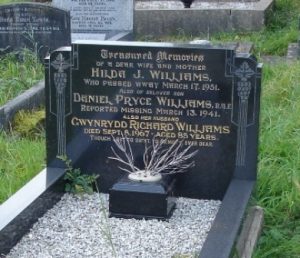Ammanford is a large town in Carmarthenshire which sits on the A483 and A474 roads, in the heart of the old coal mining area of the Amman Valley. The town of Ammanford is a relatively modern settlement, originally known as Cross Inn, and grew exponentially following the growth of the coal and tinplate industries in the nineteenth century.
Ysgol Dyffryn Aman is located at Margaret Street, Ammanford. The school was formerly known as Amman Valley Comprehensive School, prior to which it was the Amman Valley Grammar School. It originally opened as Amman Valley County School in 1913, while a new school was built. In 1970, Amman Valley Grammar School and Amman Valley Secondary Modern School merged, eventually being named Ysgol Dyffryn Aman. Twenty five former pupils of the original County School served in the forces during the Great War, one of whom lost his life, so after the end of hostilities the school saw fit to erect a marble war memorial in order to commemorate the service of these young men. This memorial is now located inside Ysgol Dyffryn Aman. The photograph of the memorial was kindly supplied by Rachel Evans, a teacher in the school, who has recently carried out a research project alongside some of her pupils.
During World War Two, the school was under the name of the Amman Valley Grammar School, and twenty-five former pupils of the school lost their lives during the latter conflict. These men are commemorated on a memorial plaque, which was unveiled in the school on Thursday 5 May 1949. This page commemorates the men named on both the WW1 and WW2 memorials
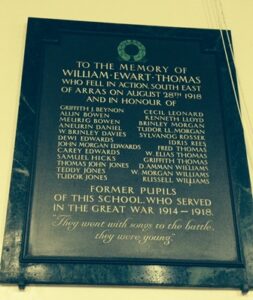
TO THE MEMORY OF
WILLIAM EWART THOMAS
WHO FELL IN ACTION SOUTH EAST
OF ARRAS ON AUGUST 28TH 1918
AND IN HONOUR OF
GRIFFITH J. BEYNON CECIL LEONARD
ALUN BOWEN KENNETH LLOYD
MEURIG BOWEN BRINLEY MORGAN
ANEURIN DANIEL TUDOR LL. MORGAN
BRINLEY DAVIES SYLVANOG ROSSER
DEWI EDWARDS IDRIS REES
JOHN MORGAN EDWARDS FRED THOMAS
CAREY EDWARDS W. ELIAS THOMAS
SAMUEL HICKS GRIFFITH THOMAS
THOMAS JOHN JONES D. AMMAN WILLIAMS
TEDDY JONES W. MORGAN WILLIAMS
TUDOR JONES RUSSELL WILLIAMS
FORMER PUPILS
OF THIS SCHOOL WHO SERVED
IN THE GREAT WAR 1914-1918
“They went with songs to the battle.
They were young.”
William Ewart Thomas, Private, 94324, Kings Liverpool Regiment. William was the son of John and Annie Thomas, of Amman Stores, Ammanford. He enlisted at Llandeilo into the 9th Battalion, King’s Liverpool Regiment, which was a service, or war time only, battalion, attached to 172 Brigade, 57th (2nd West Lancs) Division. The Division moved to France during February 1917, and moved to positions near Ypres, where it took part in the Second Battle of Passchendaele. In 1918 they took part in the 1918 Battle of the Scarpe, and at the Battle of Drocourt-Queant. William was killed in action near Arras on 28 August 1918, aged only nineteen. He has no known grave, and so is commemorated on the Vis-En-Artois Memorial, France.
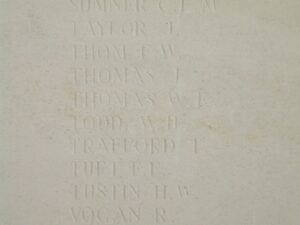
There is a varied amount of information available for the men who served and survived the Great War. I have left the research on these men to the pupils at Ysgol Dyffryn Aman who have recently published their findings.
World War Two, 1939-1945
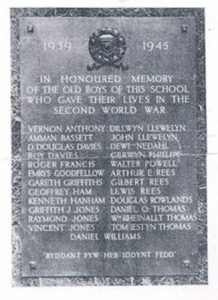
Leo Vernon Anthony, Sergeant, 1313259, Royal Air Force Volunteer Reserve. Leo was the son of John Watkin Anthony and Griselda Maud of Llandybie, and the husband of Una Anthony, of Swansea, and he served in 153 Squadron, RAF. The squadron formed on 24 October 1941 at Ballyhalbert, from ‘A’ Flight of No 256 Squadron, which had moved there on 14 October from Squires Gate. It operated Defiant’s on night fighter duties until May 1942 but in December, a Blenheim arrived for training and in January the process of converting the squadron onto Beaufighter’s began in earnest. The squadron continued to provide night defence of Northern Ireland until December when it moved to North Africa, where the squadron provided night cover to Allied forces as well as providing protection to convoys from a range of advanced bases. Leo was serving at one of these advanced bases at Malta when he was killed on 23 June 1943, aged 23. He is commemorated on the Malta Memorial.
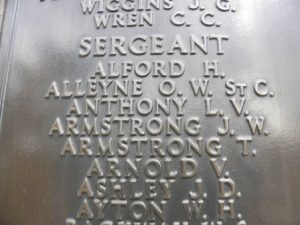
Goronwy Amman Bassett, Flight Sergeant, 930637, Royal Air Force Volunteer Reserve. Goronwy was the son of Evan and May Bassett of Ammanford, and the husband of Georgia Mary Bassett, of West Cross, Swansea. He served with 644 Squadron, RAFVR, which flew the Halifax Heavy Bomber. Goronwy flew among the crew of Pilot Alex Turnbull which had successfully taken part in ten bombing missions over occupied Europe by the time of their last flight on the night of 23 April 1945. The crew were part of a force which had been sent from RAF Tarrant Rushton to drop supplies to the Norwegian Resistance, and were on the return leg of their mission on the morning of 24 April 1945 when they were hit by anti-aircraft fire. The Halifax lost power from two of its engines due to one of the shells hitting its fuel tank, and crash-landed into Lake Mjosa in Norway. The entire crew bar one perished. Goronwy was 34 years old, and is commemorated on the Runnymede Memorial, Surrey. Four of his fellow crewmen are buried at Lillehammer. The aeroplane was recovered from the lake in the 1980’s, and moved to Canada, where it has undergone restoration. It is now on display at the RCAF Museum at Trenton, Canada.
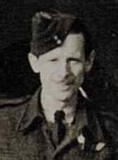
David Douglas Davies, Gunner, 1492340, Royal Artillery. David was born in Ammanford on 31 July 1918, the son of William Davies and Catherine Jane Davies (nee Morgans). The family had moved to Milton House, Saron Road, Bynea prior to the war. David enlisted into the Royal Artillery, and was posted out to Malaya, to join 7 Coast Regiment, Royal Artillery. The Regiment was formed in the summer of 1940 and formed part of the defences of Singapore, and David would have been sent out following its creation, as extra manpower was required. At the same time that the Japanese attacked Pearly Harbour, they launched an overwhelming assault on British controlled Malaya on 8 December 1941, and by 8 February 1942 the Japanese had began their assault on Singapore. Terrible fighting followed, and on 12 February 1942 the Coastal Batteries were destroyed and on the following morning the garrison was marched to the Indian Recreation Ground in Singapore where the Unit was formed into an Infantry Battalion and used as support troops. At 16.30 hours on 15 February 1942 the Regiment ceased to exist as a fighting unit, and Singapore surrendered to the Japanese. David was taken POW with the survivors of his Regiment, and was one of the thousands of Allied servicemen transferred to Burma and interned at Kanburi POW Base Camp, which served the Burma Railway Camps. He died of malaria in captivity on 9 June 1943, aged 24. David was originally buried in Kinsayoke Cemetery, but after the war his grave was exhumed, and he was re-buried in Kanchanaburi War Cemetery, Thailand.
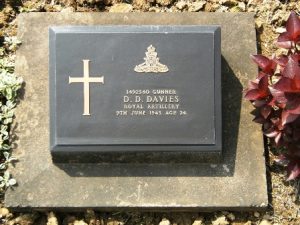
Roy Davies, Naval Airman 2nd Class, FAA/FX. 78100, Royal Navy. Roy was born at Clapham, London on 23 June 1919, and had been fostered by his eldest sister, Elizabeth Mary Davies, of Heol Brown, Tycroes. He worked as a Solicitor’s Clerk at Llanelli prior to the war. Roy enlisted into the Royal Navy, and after completing his training, was among was among 142 members of the Fleet Air Arm who embarked at Liverpool aboard the SS Almeda Star, which set sail on 15 January 1941, bound for the River Plate, for postings to HMS Goshawk, the Royal Naval Air Station at Trinidad. The Almeda Star was steaming through the Western Approaches, just two days into her voyage, on 17 January 1941, when she was spotted by the German submarine U-96, which fired a torpedo at the unsuspecting liner, striking her in the side. The ship shuddered to a halt, and the Germans fired another submarine at her before shelling her with their 88mm deck-gun and sinking her. Roy was among 360 people lost during the sinking that day. The 21-year-old has no known grave and is commemorated on the Lee-on-Solent Memorial, Hampshire.
Roger Owen Francis, Sergeant (Wireless Op/ Air Gunner), 982893, Royal Air Force Volunteer Reserve. Roger was born early in 1921, the son of John and Elizabeth Francis (nee Rogers), of Llanedi. Roger enlisted into the Royal Air Force Volunteer Reserve and trained as a Wireless Operator/ Air Gunner before being posted to 9 Squadron, RAF, which was a bomber squadron, equipped with the Vickers Wellington. At 22.05 hrs on the night of 10/11 April 1942, Roger took off aboard Wellington X3702 from RAF Honington, to bomb Essen, Germany. Soon after crossing into Germany, the aircraft was shot down and crashed at Himmelgeist on the east bank of the Rhine. All of the crew were killed, including Roger, who was 21 years old. The crew were buried side by side at Rheinberg War Cemetery, Germany.
Emrys Goodfellow, Sergeant, 1176272, Royal Air Force Volunteer Reserve. Emrys was the son of John Goodfellow and Elizabeth Goodfellow (nee Griffiths), of Plain View, Penygroes. He served as an Observer with 37 Squadron, Royal Air Force, which was based at Gadarbia West, Malta, equipped with the Vickers Wellington III. On the night of 9 March 1943, Malta was suffering from German dive bombers. In the confusion, the Wellington, Serial DV 483, which Emrys was a crewman aboard, was taking off from the runway at Luqa when it collided with a Wellington bomber which was taxiing down the runway towards them. Both aircraft burst into flames, and rescue attempts were hampered by exploding bombs which were aboard both aircraft. Emrys was 28 years old when he died that night, and was buried in Malta (Capuccini) Naval Cemetery, Malta.
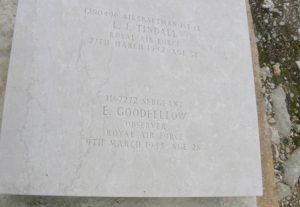
David Gareth Griffiths, Sergeant, 1316486, Royal Air Force Volunteer Reserve. David was the son of David and Hannah Griffiths, of Brynamman. He enlisted into the Royal Air Force Volunteer Reserve, and was posted to 204 Squadron, RAF. The Squadron came under RAF Coastal Command, flying the Short Sunderland, and had begun the war based in Mount Batten, Devon. They moved to the Shetland Islands for a short period, and then spent three months at Iceland before moving to Gibraltar in July, 1941. In August 1941 they moved to Bathurst in Gambia, and the following year, were re-equipped with the Mark III Sunderland, which was a better armed and equipped aircraft than their previous version. David lost his life when his aircraft was lost on 18 July 1943. He was just 20 years old and is commemorated on the Runnymede Memorial, Surrey.
Geoffrey Ham, Private, 5338501, The Queen’s Royal Regiment (West Surrey). Geoffrey was born at Sketty, Swansea, in 1919, the son of Frederick William Ham and Annie Cecilia Ham (nee Williams). His father worked for the Great Western Railway, and the family then moved to Ammanford, where Geoffrey was educated at the Grammar School, before moving again to 45, Tanycoed, Burry Port. Geoffrey enlisted into the army and was posted to the 2/6th Battalion, Queen’s Royal West Surrey Regiment. The battalion had fought during the fall of France in 1940, before moving to the Middle East to take part in the campaign against Rommel’s Afrika Korps. Geoffrey was killed during the drive across the desert, near Enfidaville on 29 April 1943. The 23-year-old has no known grave, and is commemorated on the Medjez-El-Bab Memorial, Tunisia.
Kenneth Gwyn Hanham, Ordinary Seaman, Merchant Navy. Kenneth was born at Llanedi in 1922, the son of John Hanham and Elizabeth Hanham (nee Evans). He played rugby for Tycoes RFC prior to the war. Kenneth married Catherine Ann Llewelyn, of Glanamman, in 1941, just prior to enlisting into the Merchant Navy. He was posted aboard the SS Sourabaya, a Jersey registered converted whaling ship. She left New York on 18 October 1942, with a cargo of fuel oil, war stores, and 87 passengers, in Convoy HX-212. On 27 October 1942, South-East of Cape Farewell, U-436 fired a spread of three torpedoes into the convoy of which the third torpedo hit the Sourabaya sinking her. Kenneth died that day. He was 20 years old, and is commemorated on the Tower Hill Memorial, London. He was the holder of the King’s Commendation for Brave Conduct.
Griffith John Jones, Trooper, 7922755, Royal Tank Regiment. Griffith was the son of Thomas and Mary Ann Jones, of Brynamman. He enlisted into the army and was posted to the Royal Armoured Corps, in their 47th (Oldham), Royal Tank Regiment. The Battalion had been formed by the conversion of a Battalion of the Manchester Regiment’s Infantry to an armoured Battalion in 1938, and formed part of the Territorial Army. They fought in the Western Desert during the Battles of El Alamein in 1942, which is where Griffith was killed in action on the 27 October 1942. He was 32 years old and is buried in El Alamein War Cemetery, Egypt.
Henry Raymond Jones, Sergeant (Bomb Aimer), 1419935, Royal Air Force Volunteer Reserve. Henry was the son of Albert Sydney and Hannah Jones, of Sunny Bank, Penygroes. His father had served with the 9th Royal Welsh Fusiliers during the Great War. Henry served with 78 Squadron, Royal Air Force, which was equipped with the Handley Page Halifax II, based at RAF Breighton. On the night of 24 August 1943, Henry took off from RAF Breighton aboard Halifax II, Serial JB874, which was bound for Berlin. The aircraft was in formation above Hull when it collided with another Halifax, and was sent crashing to the ground, killing all bar one of her crew. Henry was 21 years old when he died that night, and is buried in Penygroes Independent Chapelyard.
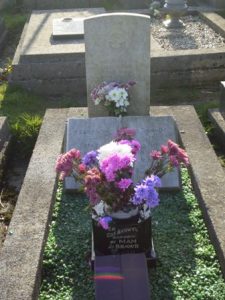
Vincent Jones. Vincent cannot presently be identified.
Dilwyn Llewelyn, Pilot Officer (Bomb Aimer), 131972, Royal Air Force Volunteer Reserve. Dilwyn was the son of Thomas and Catherine Gwendoline Llewelyn, of Garnant. He enlisted into the Royal Air Force Volunteer Reserve, and trained as a Bomb Aimer, before being commissioned as a Pilot Officer on 9 October 1942, and was posted to 21 Operational Training Unit, at Moreton-in-Marsh. During the evening of 26 January 1943, Dilwyn took off from Moreton-in-Marsh aboard a Vickers Wellington IX, Serial X9667, which had been despatched on a Bullseye sortie which involved the crew in flying out over the North Sea to a position at least fifty miles off the coast. During the early hours of the following morning, 27 January 1943, the Wellington was intercepted and shot down by a German night-fighter, crashing into the Waddenzee, with the loss of all six of her crew. The bodies of all of the men were later recovered from the sea, with Dilwyn’s remains being washed up Den Helder harbour on 8 April 1943. The 22-year-old was originally buried in Huisduinen, but after the war his remains were exhumed, and he was re-interred in Bergen-Op-Zoom War Cemetery, Netherlands.
John Llewelyn, Sergeant (Pilot), 1381320, Royal Air Force Volunteer Reserve. John was born on 16 April 1918, the son of John Morgan Llewelyn and Elizabeth Llewelyn, of Cwmberach Farm, Glanamman. He enlisted into the Royal Air Force Volunteer Reserve at the outbreak of war, and was selected for pilot training. After receiving his initial training in the USA, John returned to Britain, and was posted to 19OTU at RAF Kinloss. On 21 August 1942, John was piloting an Avro Anson, Serial DJ106, which took off on a navigational training flight. Visibility was probably poor, and the aircraft crashed into the top of Ben Macdui in the Cairngorms, killing John and his four crewmen. Their bodies were recovered two days afterwards, three of the men being buried at Kinloss, one at Windermere, and John at Garnant (Old Bethel) Welsh Congregational Chapelyard. Many thanks to John’s nephew, Geraint Llewelyn, for the photograph of John, taken before leaving the family home in 1941.
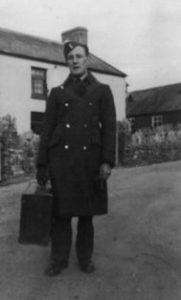
Dewi Marlais Nedhal, Flying Officer, 138211, Royal Air Force Volunteer Reserve. Dewi was the son of Roderick and Esther Nedahl, of Burry Port. He enlisted into the Royal Air Force Volunteer Reserve, and after completing his training was posted to 255 Squadron, R.A.F. The Squadron was based at Malta in 1943, flying the Bristol Beaufighter VIF, based at Bo Rizzo. Dewi was taking part in a flight on 26 September 1943, when his aircraft was lost on patrol over the Mediterranean. He was 22 years old and is remembered on the Malta Memorial.
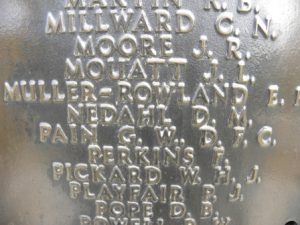
Gerwyn Phillips, Flying Officer (Navigator), 153228, Royal Air Force Volunteer Reserve. Gerwyn was the son of Evan Phillips and Martha Phillips (nee Griffiths), of Greenfield, Garnant. His father had served with the Royal Navy during the Great War. Gerwyn enlisted into the Royal Air Force Volunteer Reserve and after training as a Navigator in Canada, under the Empire Air Training Scheme, was posted to 605 Squadron, RAF, which was based at RAF Hartford Bridge, Hampshire, equipped with the De Havilland Mosquito. The Squadron carried out intruder raids over Germany during the final year of the war. On 22 February 1945, Gerwyn and his pilot Edward Leonard Jones, took off from Hartford Bridge in Mosquito PZ406, which joined a large force of aircraft sent to attack targets in Germany. During the afternoon, Gerwyn’s aircraft was hit by anti-aircraft fire, and crashed near Herbrum, near Aschendorf, Germany, killing both men. Gerwyn was 23-years-old when he died in the crash, and is buried next to his pilot in Reichswald Forest War Cemetery, Germany.
Walter Powell. Walter cannot presently be identified.
Arthur Edwin Rees, Sergeant, 934390, Royal Air Force Volunteer Reserve. Arthur was the son of Edwin Thomas Rees and Sarah Adelina Anne Rees (nee Jones), of Penygroes. He enlisted into the Royal Air Force Volunteer Reserve, and after completing his training as a Pilot was posted to 214 Squadron, RAF. The squadron was a heavy bomber unit, equipped the Vickers Wellington, based at RAF Stradishall. On 1 April 1942, Arthur took off from Stradishall aboard Wellington IC, Serial R1789, on an operational flight over Hanau, Germany, when it was shot down and crashed near Mannheim, Germany, in the early hours of 2 April 1942, killing all her crew of six. Arthur was 21-years-old when he was killed during the crash, and is buried alongside his fellow crew in Durnbach War Cemetery, Germany. His brother, James Gilbert Rees, had been killed at sea in 1940.
James Gilbert Rees, First Radio Officer, Merchant Navy. James was born at Upper Brynamman on 12 September 1913, the son of Edwin Thomas Rees and Sarah Adelina Anne Rees. He served with the Merchant Navy aboard the S.S. Harpalyce, a London registered cargo steamer. On 25 August 1940 she was off the Hebrides, returning from Halifax for Hull as part of Convoy HX-65A, carrying a cargo of 8000 tons of steel, when she was torpedoed and sunk by the German Submarine U-124, with the loss of 37 lives. James was 26 years old when he died that day, and is commemorated on the Tower Hill Memorial, London. His brother Arthur was killed in 1942.
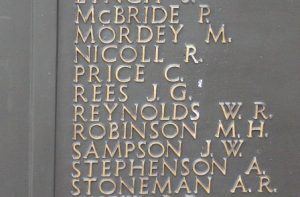
Lewis Howell Rees, Corporal, 5187579, Gloucestershire Regiment. Lewis was the son of Bryn and Rachel Rees, of Brynamman. He enlisted into the army and was posted to the 1st Battalion, Gloucestershire Regiment. The Battalion served in the Far East, in a terrible campaign against the Japanese following their invasion of Burma. When the Japanese declared war, the 1st Battalion, The Gloucestershire Regiment was based at Rangoon, one of only two British battalions in Burma employed in internal security duties. Following the Japanese invasion of Burma at the beginning of the 1942, the Battalion was guarding the approaches strategic points around Mingaladon airfield. After British defeats at Sittang and Pegu, the road to Rangoon lay open and the decision was made to evacuate the city in February 1942. The battalions first action against the Japanese was at Taukkyan on 7/8 March 1942, and broke a Japanese roadblock to the north of Rangoon which had cut off the 17th Indian Division, and General Sir Harold Alexander, commander of the Burma Army. The depleted force then began to retreat, although the Gloucesters forced a successful counter-attack against the Japanese two weeks later. Lewis was killed during this latter action in Burma on 2 April 1942, aged 23. He has no known grave and is commemorated on the Rangoon Memorial, Myanmar.
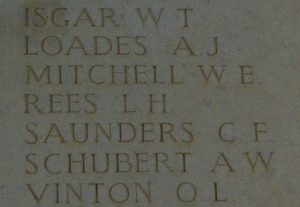
Douglas Rowlands, Private, 7371737, Royal Army Medical Corps. Douglas was the son of John Rowlands and May Rowlands (nee Morgan), of Moorcroft, Glennig Road, Glanamman. He served with the Royal Army Medical Corps. No more is known of him, but he died on active service at Carmarthen on 6 March 1945, aged 29. Douglas is buried in Garnant (Old Bethel) Welsh Congregational Chapelyard.
Daniel Owen Thomas, Flying Officer, 124699, Royal Air Force Volunteer Reserve. Daniel was the son of William Henry and Ruth Thomas, of Ammanford. He enlisted into the Royal Air Force Volunteer Reserve, and was posted to 83 Squadron, RAF. The Squadron was part of RAF Bomber Command, and by 1942 was equipped with the Lancaster Bomber. The Squadron had already made a name for itself before being transferred to RAF Wyton as part of the elite Pathfinder Force. The Squadron took part in missions over Northern Italy, the Ruhr Valley, and started bombing targets in Hamburg during the first few months of 1943. On the night of 12 June 1943, the Squadron was returning from a mission to drop target indicators on Munster, when Daniel’s Lancaster, piloted by Squadron Leader James Eric Swift DFC, was shot down over the English Channel. The whole crew was lost, but the bodies of Swift and another crewman Sgt. J. J. Anderton were washed ashore. Daniel was 26 years old, and is commemorated on the Runnymede Memorial.
Thomas Yestyn Thomas, Flying Officer (Navigator), 154395, Royal Air Force Volunteer Reserve. Thomas was the son of Haydn Garnant Thomas and Anne Thomas, of Garnant. He enlisted into the Royal Air Force Volunteer Reserve, and after training as a Navigator was posted to 550 Squadron, RAF. The Squadron was equipped with the Avro Lancaster II, and was based at RAF North Killinghome. On the night of 3-4 October 1944, Thomas was one of the crew of Avro Lancaster Mk I, Serial NF963, which was badly damaged after returning from a mission over Germany. She broke up in mid air, and dived into the ground near to Ellingstring in North Yorkshire, killing all her crew apart from the pilot, Stanley Hayter, who had managed to parachute out. Thomas was officially recorded as having died on 4 October 1944. He was 22 years old, and is buried at Garnant (Old Bethel) Welsh Congregational Chapelyard.
William Rheinallt Thomas, Private, 7618185, Royal Army Ordnance Corps. William was the son of William Sydney and Hannah Maria Thomas. He enlisted into the army and was posted to the 1st Advance Ordnance Workshop, Royal Army Ordnance Corps. Very little is presently known of William, but he died on 10 September 1940, aged just 22. William has no known grave and is commemorated on the Brookwood Memorial, Surrey, so was possibly lost at sea.
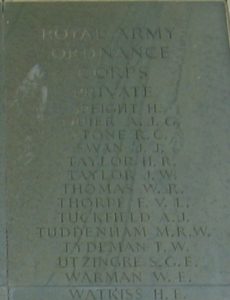
Daniel Pryce Williams, Sergeant, 970459, Royal Air Force Volunteer Reserve. Daniel was born on 11 July 1917, the son of Gwyn Richard Williams and Hilda Jane Williams (nee Price), of Stationer’s Hall, Cwmamman. He enlisted into the Royal Air Force Volunteer Reserve, and was posted to 77 Squadron, RAF, which flew the Armstrong Whitworth Whitley V, based at RAF Topcliffe. On 13 March 41, Daniel took off from Topcliffe aboard Whitley V, Serial N1493. About two hours into the flight, a radio transmission was received from the aircraft, calling for assistance. No trace of the Whitley was ever found, it disappeared with all its crew of five men. Daniel was 23-years-old when he was killed that night, and is commemorated on the Runnymede Memorial, Surrey. His fellow crewmen who perished alongside him were Sergeant D. W. Arkwright, Sergeant D. A. Smithies, and Sergeant S. W. Snoddon.
